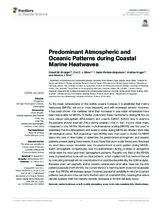Predominant atmospheric and oceanic patterns during coastal marine heatwaves
Date
2017Author
Schlegel, Robert W.
Oliver, Eric C. J.
Perkins-Kirkpatrick, Sarah
Kruger, Andries
Metadata
Show full item recordAbstract
As the mean temperatures of the worlds oceans increase, it is predicted that marine
heatwaves (MHWs) will occur more frequently and with increased severity. However,
it has been shown that variables other than increases in sea water temperature have
been responsible for MHWs. To better understand these mechanisms driving MHWs we
have utilized atmospheric (ERA-Interim) and oceanic (OISST, AVISO) data to examine
the patterns around southern Africa during coastal (<400 m from the low water mark;
measured in situ) MHWs. Nonmetric multidimensional scaling (NMDS) was first used to
determine that the atmospheric and oceanic states during MHW are different from daily
climatological states. Self-organizing maps (SOMs) were then used to cluster the MHW
states into one of nine nodes to determine the predominant atmospheric and oceanic
patterns present during these events. It was found that warmwater forced onto the coast
via anomalous ocean circulation was the predominant oceanic pattern during MHWs.
Warm atmospheric temperatures over the subcontinent during onshore or alongshore
winds were the most prominent atmospheric patterns. Roughly one third of the MHWs
were clustered into a node with no clear patterns, which implied that they were not forced
by a recurring atmospheric or oceanic state that could be described by the SOManalysis.
Because warm atmospheric and/or oceanic temperature anomalies were not the only
pattern associated withMHWs, the current trend of a warming earth does not necessarily
mean that MHWs will increase apace; however, aseasonal variability in wind and current
patterns was shown to be central to the formation of coastal MHWs, meaning that where
climate systems shift from historic records, increases in MHWs will likely occur.

